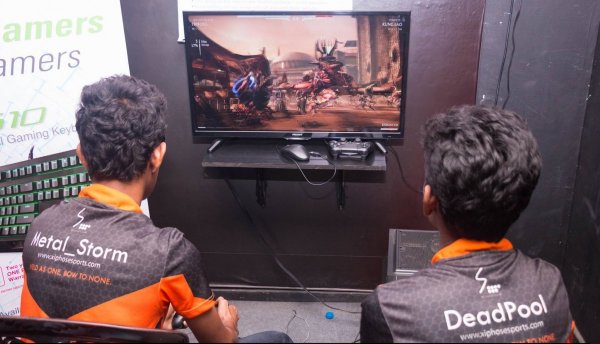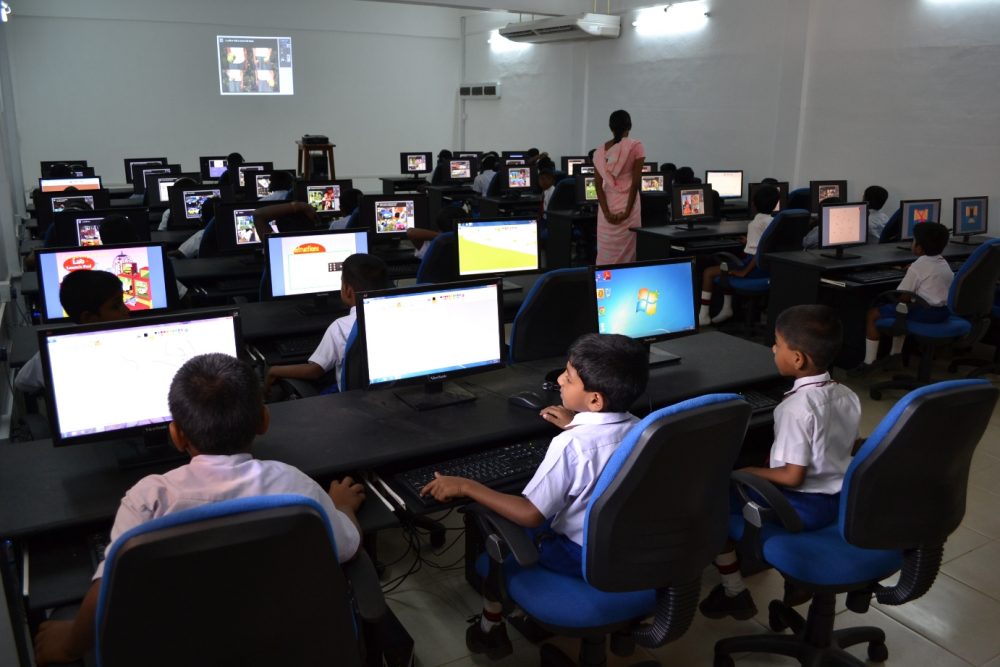
Sri Lanka has been reasonably successful in its adoption of ICT, getting commercial internet about 21 years ago, and greatly increasing acquisition of personal computers since then. Internet penetration has been estimated at 22 percent to 34 percent in the country, though taking a look at gags.lk, you’d think it was more.
There is no smoke without fire, and there are no memes without a certain degree of computer literacy and boredom. How far along is the adoption of ICT in Sri Lanka and how proficient are we in its use? The Department of Census and Statistics has a report out on computer literacy in Sri Lanka in 2015, and it’s pretty interesting.
The survey is useful for a multitude of reasons, some of which they elaborate:
“For this computer literacy data, can contribute immensely to an understanding of the demand and supply of skills in the global, knowledge based economy. Also statistics on the availability of a computer/laptop in households and usage of internet and email can be used to asses digital devide.” (sic)
Apparently, spell check wasn’t part of the survey methodology.
Computer Definitions
The census sampled 25,000 households. The people surveyed were between the ages of 5 and 69. We couldn’t hazard a guess on that specificity for the upper age limit. It’s probably something Freudian. If the household had a PC or a laptop, then it was considered to be a “computer owned household” (sic). If a five year old can play a video game, then that child is considered computer literate. They obviously haven’t seen some of the games out there.
We’re not quite sure this definition works so well these days. The power of a smartphone or a tab is easily equivalent to that of a PC a decade ago, but the definition of computer literacy here doesn’t reflect this. With so much hybrid hardware and hybrid operating systems in use, these definitions need upgrading.
Ownership
By 2015, 24 percent of households in the country owned at least one computer ‒ that’s one out of every four homes. In 2009, the percentage was as low as 11.4. So, there has been growth, but not to an extent we’d expect. We are still lagging behind our APAC neighbours and are pretty far behind the US, where 85 percent of households have a computer (2014 data from ITU). India doesn’t have any recent data available.
Perhaps unsurprisingly, the majority of households with computers are concentrated in urban areas, with 41.5 percent having computers, while only 22 percent of households in rural areas own computers. In estate areas (which seem to be considered separate from urban or rural) only 4.5 percent of households have computers.
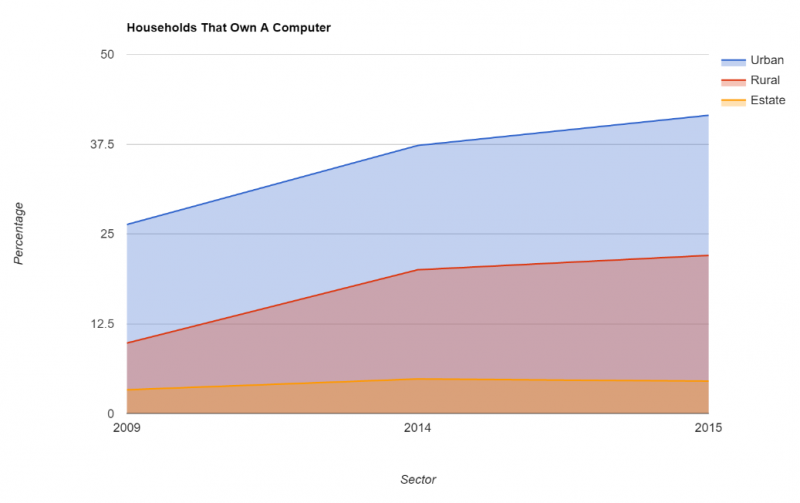
Percentage of computers owned by households by sector
Area-wise, the Western Province takes the transistor with 38.5 percent of households owning a computer. The Uva province has the least concentration of computers, with only 12.5 percent of households having one. But it has to be taken into consideration that the province is the second least populated province in the country.
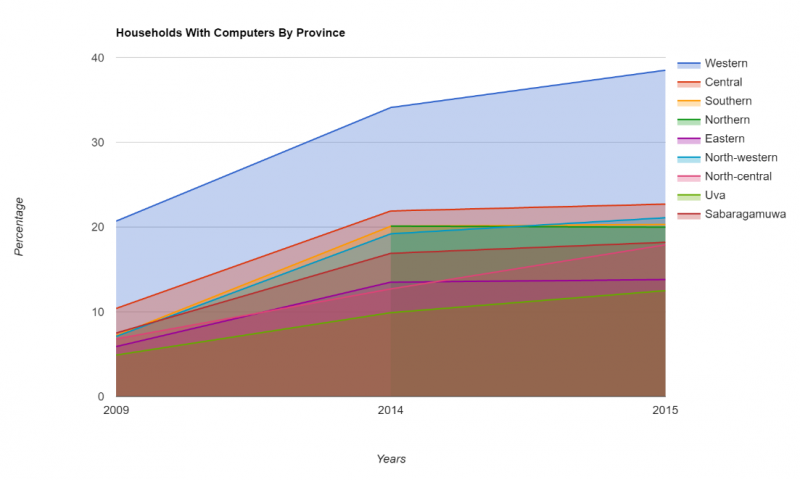
Percentage of computers owned by households by province
All the provinces have shown large percentage increases in computer ownership since 2009, which is a pretty good sign, and an indication that tech is more easily accessible now. Of rural households that own a computer now, 61 percent acquired their first one within the last five years.
Literacy
On average, 27.1 percent of Sri Lankans are computer literate, which is just a few percentage points over the number of households that own a computer. You’d think the number would be higher.
Again, the urban population has a higher percentage of literacy (39.2%) compared to rural areas (25.5%). The Western Province again is the highest, as expected, with 38.4 percent literacy, and the Southern Province the next closest with 27.3 percent literacy.
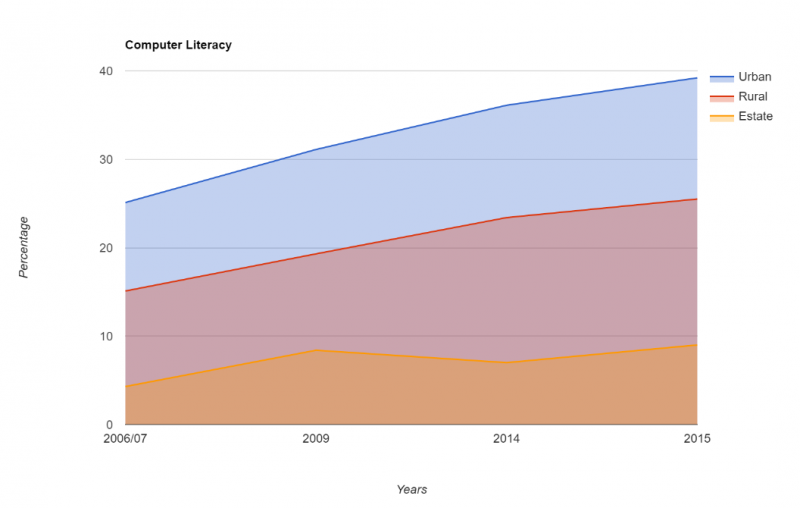
Computer literacy by sector
District-wise, Colombo is at the top with 45.3 percent computer literacy. Gampaha is next with 34.2 percent.

Computer literacy by district
Looking at literacy by gender and age shows some interesting distributions. Males have a higher computer literacy compared to females ‒ 29.1 percent to 25.3 percent. It’s not the hugest gap, which is good, but the fact that there is a difference of several percentage points means there’s room for improvement.
Among the age groups, teenagers between 15 to 19 are the most literate at 58.7 percent, with young adults between 20 and 24 coming in a close second at 53.8 percent. That’s the age band that’s most involved with ICT. It’s interesting to note that 5- to 9-year-olds have a 14 percent literacy rate.
Those who passed their A/Levels were also more literate (70 percent) than those who hadn’t reached that level of education. Clerks were the most literate employment group (88.7 percent) with professionals coming in next with 84 percent. Why these highly literate clerks are unprofessional, we couldn’t guess.
There is a significant correlation between language and computer literacy. English speakers are the most computer literate at 69.5 percent with Sinhalese speakers coming in at 33.1 percent and Tamil speakers at 26.9 percent. This might indicate the biggest reason for the low literacy around the island. Language is proving a barrier to accessibility.
The Internet
We’ve taken a look at the quality of Sri Lanka’s internet before ‒ it’s not too bad, really. The 2015 Department of Census report states that 12 percent of their survey sample used the internet at least once during the year. The numbers we’ve seen, however, put internet penetration at over 20 percent.
The rest of the data goes pretty much as you’d expect. Colombo has the highest use of internet at 28 percent. Gampaha comes in second at 18.7 percent. It’s interesting to see how close Gampaha is, in ICT literacy. Badulla is the lowest, with 3.4 percent.

Internet usage per household
In A Nutshell
The Computer Literacy Statistics report by the Department of Census and Statistics is an insightful resource. It’s definitions are a bit archaic and need updating, it is in definite need of a spell check and an editor, but it is recent and highlights the state of computer literacy in Sri Lanka. Not every country has up-to-date stats on ICT literacy.
So, in summary, 1 in 4 Sri Lankan households has a computer, mostly bought in the last five years, concentrated in the Western Province and operated by English speaking young adults in their early 20s who have passed their A/Levels and may end up becoming professionals (who are different from clerks). There is also a small percentage of precocious five years olds who we need to keep an eye on, just in case they end up hacking NASA at 13.
Featured image courtesy visionsglobalempowerment.org




